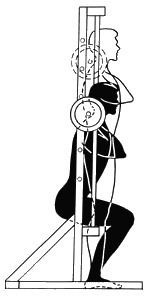 | ||
The Smith machine is a weight machine used for weight training. It consists of a barbell that is fixed within steel rails allowing only vertical or near-vertical movement. Some Smith machines have the barbell counterbalanced. The machine can be used for a wide variety of exercises though it is most commonly used to perform "Smith machine squats".
Contents
Use as a self-spotting device
Behind each vertical post (runner) is a series of slots on which the barbell can be hooked. This means that unlike an ordinary barbell, the Smith machine need not be re-racked after a set of repetitions: it can be secured at any point. This supposedly makes it safer for those who lift without a spotter, as one only needs to twist the wrist in order to lock the barbell in place in the event that the weight becomes too great. Most models also incorporate blocks, pegs, or other devices which can be adjusted to automatically stop the barbell at a predetermined minimum height.
This does not fully eliminate the inherent danger in having a heavy weight on one's back, however, and may instill a false sense of confidence. In 2001, a Smith machine user became quadriplegic when the apparatus crushed his spine.
Advantages and disadvantages
Use of the Smith machine is frowned upon by many strength training devotees as it forces the user to adopt an unnatural straight-up-and-down "bar path" which can put shear stress on the knees or back (if squatting) or shoulders (if pressing).
The constrained movement of the bar also reduces the role that stabilising muscles play versus an exercise using free weights. This may allow heavier weights to be lifted, at the expense of engaging less muscle mass overall.
As with other exercise machines, the Smith machine is often preferred by casual or inexperienced strength trainees who do not know how to safely perform free weight exercises involving heavy weights.
Many gyms cater to casual trainees and thus may provide Smith machines instead of power racks, which are a piece of equipment critical for safely performing squats and other barbell-based free weight exercises. As a consequence, free-weight squatting may not even be an option at many gyms.
The Smith machine does have some advocates amongst experienced trainees, however. The "bar path" issue is minimized for exercises involving a short range of travel such as calf raises and shrugs. It is potentially good for performing exercise variations when progress has slowed using other exercise forms, although care must be taken to avoid joint stress issues. The removal of stabilizing muscles as a factor can also allow one to increase the intensity applied to primary muscles.
Origin
The Smith machine was invented by American Jack LaLanne, who rigged up a sliding apparatus in his gym in the 1950s. It was spotted by men's bath house manager Rudy Smith, who commissioned Paul Martin to improve it. Smith then installed the modified model in a gym he was managing at the time, Vic Tanny's gym in Los Angeles. By the end of the 1950s, Rudy Smith was an executive in Tanny's chain of gyms, and the Smith machine was being manufactured and sold more widely.
Effectiveness
When Jack LaLanne invented the Smith machine, he used it as part of a complete muscle-toning regime utilizing free weights too. LaLanne never intended it to be used, particularly, to isolate and bulk up one muscle group.
Research published in December 2009 reported that free weights triggered 43% more activation of the muscles than a Smith machine when performing squats.
